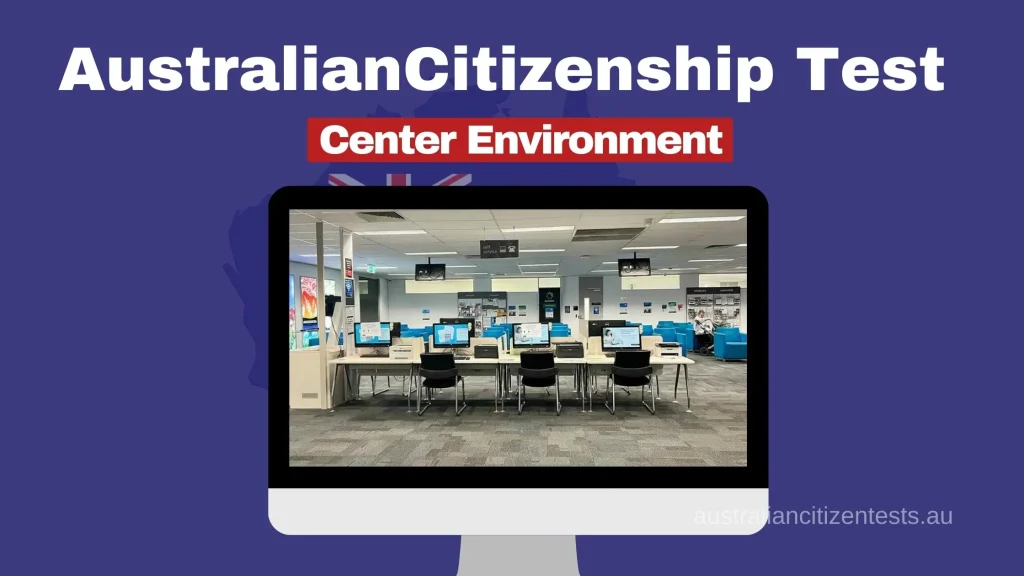
The Australian Citizenship Test is run by the Department of Home Affairs and Pearson VUE using strict rules to keep the process fair. Before starting, candidates must show a photo ID (like a passport or driver’s license) and complete bio metric checks, such as fingerprint scans and signature matching. Banned items—including phones, bags, notes, and electronics—must be left in lockers outside the test room. Inside, everyone gets a private computer workstation, and cameras watch the room to stop distractions or cheating.
Test centres are set up the same way nationwide to ensure equal test day conditions. While there’s no strict dress code, avoid hats or clothing that hides your face (except for religious reasons). Staff members watch closely to make sure no one talks, moves around, or breaks rules. These steps—like ID checks, secure storage for personal items, and monitored workspace—help balance safety with fairness for all candidates.
Test Centre Setup & Conditions
The test environment priorities standardised conditions and strict protocols to ensure fairness for all applicants.
Physical Environment & Security Measures
Test centers enforce quiet, monitored conditions through surveillance systems and on-site staff. Candidates must follow rules like no talking or accessing personal items during the test, with violations leading to disqualification. These protocols ensure compliance and minimize distractions.
Seating & Workspace Setup
There’s no pre-assigned seating. Applicants arrive at their scheduled time and are directed to an individual workstation with a computer terminal. Workstations are spaced apart to prevent distractions, and screens are angled to block visibility from neighboring desks. This setup ensures equal testing conditions for all candidates, with no advantage based on seating position. Identity checks (as outlined in the introduction) are reconfirmed before the test begins.

Security & Identity Verification Procedures
The Australian Citizenship Test uses strict rules to keep the test fair and stop cheating.
Bio metric & Identity Verification
You must show ID like a passport or driver’s license to prove who you are. Staff will also scan your fingerprints or take a photo of your face to match government records. These checks happen before the test starts to make sure no one pretends to be someone else.
Prohibited Items & Test-Day Rules
Phones, bags, and notes are not allowed in the test room. You can store these in lockers outside. During the test, you must stay quiet, sit in your seat, and follow all instructions. Breaking these rules could cancel your test.
Technical & System Setup for the Test
The Australian Citizenship Test is mostly done on computers to keep things fair and quick. Some people can get special paper tests if needed.
Computer-Based Testing Conditions
Candidates use computers set up with special software Pearson VUE Test tool that block outside websites or apps. The computers are locked down so no one can cheat. The screens are easy to read, with clear instructions to help you move through the test.
Paper-Based Test Environment
For applicants with disabilities, like vision issues, paper tests are available. These might have bigger text or other changes to make the test easier. You need to ask for this option before test day and get it approved.
How Should You Behave During the Australian Citizenship Test?
- Maintain Silence: Candidates must adhere to a strict no-talking policy during the test to ensure a fair environment.
- Follow Supervisor Instructions: Test center supervisors oversee the examination process; candidates are required to comply with their directions at all times.
- Prohibited Items: Personal belongings, including mobile phones, bags, and notes, are not allowed in the test room. Secure storage options are typically provided.
- Consequences of Misconduct: Engaging in prohibited behaviors, such as talking or using unauthorized materials, can lead to immediate test invalidation and restrictions on retaking the test, potentially delaying the citizenship application process.
Can You Use an Interpreter During the Australian Citizenship Test?
The Australian Citizenship Test is only in English because it’s the main language used in the country. Most people can’t use an interpreter during the test. However, if you have a disability (like hearing loss) and need help, you can ask for an interpreter from TIS National, a service approved by the government. You must apply before your test day to get this approved.
While the test itself is in English, the government provides study guides in other languages to help you prepare. This way, everyone gets a fair chance to pass, even if English isn’t their first language.
What should I wear to the test?
Wear casual but neat clothes. Avoid shirts with slogans, political messages, or rude symbols to keep things respectful.
Can I bring my phone?
No. Phones and gadgets like smartwatches are not allowed in the test room. You can store your items in lockers at the centre.
Are there cameras watching?
Yes. Cameras watch the room to keep everyone safe and stop cheating.
Can I ask for help during the test?
No. Supervisors can’t explain questions—you must answer them on your own.
